- Gary Suarez
- Albums and Singles
Shitkatapult
 With anoverwhelming anglo-dominance in the techno scene, it is perhaps all-tooeasy to be ignorant or forget that even the genre's most obvious rootsare black in origin and, I assume, Lars Fenin is hoping to somewhatrectify that injustice. Though not at the level of Rhythm & Sound'snear-impeccable, devotional aesthetic, Fenin's debut album evokes arespect for this heritage and lineage with an accessible aural lessonwhere the barriers between the two genres are regularly crossed withouthesitation or explanation. Deep dancy cuts like "Aware" and the bassheavy "Konstrukt" may seem like familiar territory (or even old hat) toinformed clubgoers and home listeners who have embraced these types ofsounds, but they will likely be impressed by the heavier portions ofmore traditional reggae thrust into the mix on the opening title track,moreso particularly with its unabashed reverence to the stickiest ofthe icky. Here, vocalist Gorbi, who contributes his rootsyWailers-inspired voice to the album's finest tracks, adds a truly vitaledge to Fenin's work that sets it apart from many of his peers."Thrills," the album's lead single, bounces with a bumping downtempobeat, springy synth bass, and just enough vocal to make this apotential breakout summer jam. In that same vein, "No C.I.A." recallsthe political and social passion of the finest Jamaican toasters, withGorbi riffing fantastically over Fenin's sparse three note melody andclicky percussion. The fusion of the genre's fits together rather wellon the dub-tech groover "None Of Them," where Gorbi drops in on thefirst hard 4/4 kick and rarely ceases for most of its duration. Groundedcloses out with the subtler shuffling rhythm of "South," where thestudio aceticism of masters like King Tubby and Lee Perry is paidwell-deserved homage, making for a fiiting end to this reverent debutfrom a producer I hope to hear much more from in the future.
With anoverwhelming anglo-dominance in the techno scene, it is perhaps all-tooeasy to be ignorant or forget that even the genre's most obvious rootsare black in origin and, I assume, Lars Fenin is hoping to somewhatrectify that injustice. Though not at the level of Rhythm & Sound'snear-impeccable, devotional aesthetic, Fenin's debut album evokes arespect for this heritage and lineage with an accessible aural lessonwhere the barriers between the two genres are regularly crossed withouthesitation or explanation. Deep dancy cuts like "Aware" and the bassheavy "Konstrukt" may seem like familiar territory (or even old hat) toinformed clubgoers and home listeners who have embraced these types ofsounds, but they will likely be impressed by the heavier portions ofmore traditional reggae thrust into the mix on the opening title track,moreso particularly with its unabashed reverence to the stickiest ofthe icky. Here, vocalist Gorbi, who contributes his rootsyWailers-inspired voice to the album's finest tracks, adds a truly vitaledge to Fenin's work that sets it apart from many of his peers."Thrills," the album's lead single, bounces with a bumping downtempobeat, springy synth bass, and just enough vocal to make this apotential breakout summer jam. In that same vein, "No C.I.A." recallsthe political and social passion of the finest Jamaican toasters, withGorbi riffing fantastically over Fenin's sparse three note melody andclicky percussion. The fusion of the genre's fits together rather wellon the dub-tech groover "None Of Them," where Gorbi drops in on thefirst hard 4/4 kick and rarely ceases for most of its duration. Groundedcloses out with the subtler shuffling rhythm of "South," where thestudio aceticism of masters like King Tubby and Lee Perry is paidwell-deserved homage, making for a fiiting end to this reverent debutfrom a producer I hope to hear much more from in the future.samples:
Read More
- Joshua David Mann
- Albums and Singles
Jagjaguwar
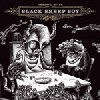 This is not to say thatit is a facsimile. Rather, it is a flirtation with the structures andtropes put forth by Jeff Mangum and company. Consider the evidence: thequiescent initial invocations of each band's protagonist (for NMH, theTwo-Headed Boy; for Okkervil, the Black Sheep Boy) occur in the firstsong and then roar grandiosely into attention-grabbing second songs.The protagonists both rear their (abhorrent) heads throughout the songson their respective albums, causing listeners to shudder and rejoice atthe same time. Songs are all similarly connected by common threads andthemes, be they musical or lyrical. The communion between NMH andOkkervil goes beyond simply the brash employment of brass instrumentsin certain songs, such as in the waltz-like "A King and a Queen." Songson both albums gracefully flow into one another, perhaps takingOkkervil's aquatic moniker too literally on one side. Okkervil River'smeditation for this album is the Black Sheep Boy's (it's unclearwhether it is a proper name and should be capitalized, or rather anarchetype and thus lower-case; excuse my presumption but I am goingwith the proper name and upper-case solution) modern-day ostracism andrejection. He seems to be some modern hybrid of the ancient figures ofAnubis, Dionysus, and the Cretan Minotaur. If the artwork on the albumis any indication, he is a grotesque abomination yet is as undeniablyfascinating as a savage automobile accident. The album begins with theeponymous "Black Sheep Boy," a proper intro of one minute and eighteenseconds which elegiacally introduces the main character with a lightcollection of guitars, strings, keyboards, and brushed percussion. Theintro seamlessly elides into the first real track, the name of whichfittingly is "For Real." Even at a first cursory listen, the song willtransfix you. It enters methodically with repetitive and monotonepluckings only to have the guitars and drums crash in unexpectedly andunannounced without breaking stride. Will Sheff's voice is occasionallystrained to its upper reaches, on the precipice of cracking for themore sonorous parts of the song. The effect is startling without beinggrating or abrasive. By the end of the song, Sheff's vocals areshattering delicately all over the place and the raw energy released bythis is pleasing and welcome. The song's energy then decays into thedulcet lethargy of "In a Radio Song" which meditates wistfully for overfive minutes. It is the gentle eddies of placid waters to the class 5rapids of "For Real." Lyrically, Okkervil River are formidablestorytellers. Their narratives sing of imperfect lives, unrequitedloves, and the darkness of forced hermitage. The ponderous "A Stone"decries the injustice of a girl who chooses to love the callous andunadoring rather than the dedicated and true. Towards the end, there isa remarkable moment when the instruments drop into the background andthe vocals emerge to narrate this allegorical and modernized fairy taleabout stones and queens and flowers. Sheff starts to insert more andmore syllables into each line (more than would normally be seemly) inorder to economize and fit the story into just one or two verses. Theresult is a two-tiered narrative which weaves itself elegantly into thestructure of the song's large ensemble/instrumentation. Like In the Aeroplane Over the Sea,there is a satisfying alternation of rockers with ballads. Energy isexpended and recouped throughout the album and requires intercedingsongs of quietude to buffer the harsher numbers. "So Come Back, I amWaiting," the penultimate song, captures both of these loud and softextremes in its pure majesty and does a fine job of condensing andsummarizing the themes from the album. In past efforts, Okkervil Riverhave hit on a mixture of successes and, well, non-successes on theiralbums. Black Sheep Boy is the full realization of the band'ssuccess into a musical suite of eleven well-formed songs, bearing noneof the ugly horns or murderous tendencies of the album's titlecharacter.
This is not to say thatit is a facsimile. Rather, it is a flirtation with the structures andtropes put forth by Jeff Mangum and company. Consider the evidence: thequiescent initial invocations of each band's protagonist (for NMH, theTwo-Headed Boy; for Okkervil, the Black Sheep Boy) occur in the firstsong and then roar grandiosely into attention-grabbing second songs.The protagonists both rear their (abhorrent) heads throughout the songson their respective albums, causing listeners to shudder and rejoice atthe same time. Songs are all similarly connected by common threads andthemes, be they musical or lyrical. The communion between NMH andOkkervil goes beyond simply the brash employment of brass instrumentsin certain songs, such as in the waltz-like "A King and a Queen." Songson both albums gracefully flow into one another, perhaps takingOkkervil's aquatic moniker too literally on one side. Okkervil River'smeditation for this album is the Black Sheep Boy's (it's unclearwhether it is a proper name and should be capitalized, or rather anarchetype and thus lower-case; excuse my presumption but I am goingwith the proper name and upper-case solution) modern-day ostracism andrejection. He seems to be some modern hybrid of the ancient figures ofAnubis, Dionysus, and the Cretan Minotaur. If the artwork on the albumis any indication, he is a grotesque abomination yet is as undeniablyfascinating as a savage automobile accident. The album begins with theeponymous "Black Sheep Boy," a proper intro of one minute and eighteenseconds which elegiacally introduces the main character with a lightcollection of guitars, strings, keyboards, and brushed percussion. Theintro seamlessly elides into the first real track, the name of whichfittingly is "For Real." Even at a first cursory listen, the song willtransfix you. It enters methodically with repetitive and monotonepluckings only to have the guitars and drums crash in unexpectedly andunannounced without breaking stride. Will Sheff's voice is occasionallystrained to its upper reaches, on the precipice of cracking for themore sonorous parts of the song. The effect is startling without beinggrating or abrasive. By the end of the song, Sheff's vocals areshattering delicately all over the place and the raw energy released bythis is pleasing and welcome. The song's energy then decays into thedulcet lethargy of "In a Radio Song" which meditates wistfully for overfive minutes. It is the gentle eddies of placid waters to the class 5rapids of "For Real." Lyrically, Okkervil River are formidablestorytellers. Their narratives sing of imperfect lives, unrequitedloves, and the darkness of forced hermitage. The ponderous "A Stone"decries the injustice of a girl who chooses to love the callous andunadoring rather than the dedicated and true. Towards the end, there isa remarkable moment when the instruments drop into the background andthe vocals emerge to narrate this allegorical and modernized fairy taleabout stones and queens and flowers. Sheff starts to insert more andmore syllables into each line (more than would normally be seemly) inorder to economize and fit the story into just one or two verses. Theresult is a two-tiered narrative which weaves itself elegantly into thestructure of the song's large ensemble/instrumentation. Like In the Aeroplane Over the Sea,there is a satisfying alternation of rockers with ballads. Energy isexpended and recouped throughout the album and requires intercedingsongs of quietude to buffer the harsher numbers. "So Come Back, I amWaiting," the penultimate song, captures both of these loud and softextremes in its pure majesty and does a fine job of condensing andsummarizing the themes from the album. In past efforts, Okkervil Riverhave hit on a mixture of successes and, well, non-successes on theiralbums. Black Sheep Boy is the full realization of the band'ssuccess into a musical suite of eleven well-formed songs, bearing noneof the ugly horns or murderous tendencies of the album's titlecharacter.samples:
Read More
- Administrator
- Albums and Singles
madrona records
 The nearly 17 minute"Histories Repeating as One Thousand Hearts Mend" marches along slowlyto a steady swell of hubcaps, marimba, and cello. "Why She SwallowsBullets and Stones" is a beautiful piano piece that breaks up the darkovertones of the previous three pieces and provides much neededbreathing room from the often dark and melancholic tone that aboundshere. This is perhaps Esmerine's greatest liability. While they aremasterful in their ability to evoke a nefarious atmosphere from theirsongs, all the melancholy and anxiety can become a little suffocating,but I give credit where credit is due. Esmerine are capable of inducinga range of clear, striking images: barren landscapes, war-torn cities,and quiet desperation. As the final bent notes on "Le Rire de L'Ange"fade away, I can almost see the mushroom cloud from my bedroom window.
The nearly 17 minute"Histories Repeating as One Thousand Hearts Mend" marches along slowlyto a steady swell of hubcaps, marimba, and cello. "Why She SwallowsBullets and Stones" is a beautiful piano piece that breaks up the darkovertones of the previous three pieces and provides much neededbreathing room from the often dark and melancholic tone that aboundshere. This is perhaps Esmerine's greatest liability. While they aremasterful in their ability to evoke a nefarious atmosphere from theirsongs, all the melancholy and anxiety can become a little suffocating,but I give credit where credit is due. Esmerine are capable of inducinga range of clear, striking images: barren landscapes, war-torn cities,and quiet desperation. As the final bent notes on "Le Rire de L'Ange"fade away, I can almost see the mushroom cloud from my bedroom window.samples:
- Quelques Mots Pleins D'Ombre
- Histories Repeating as One Thousand Hearts Mend
- Why She Swallows Bullets and Stones
Read More
- Andrew Culler
- Albums and Singles
Headz
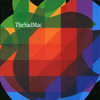 This isn't the first time Mathieu has taken up therecordings of others for his own revision, but it feels now like atotal revisioning, something with legs. What might seem like a fairlystraight-up digital drone recording up front reveals later to be acavernous amalgam of disparate sources and foreign intents feeding twosoftwares' insatiable and somehow melancholy blanket constructions bydeep and luscious weaves of histrionic and celestial noise. Theartist's own intent is either invisible or secondary to a giganticprimary. After a long list of Matheiu's sound-sourcing "collaborators"on the back of another beautiful Headz package job, each track featuresthe artist's poetic descriptions and instruments used. Three of thelonger tracks are Mathieu's commissioned sound portion for a German daVinci exhibit. Another is a dance piece soundtrack featuring violadrones run through "the Death Chimes of a Macintosh Classic IIcomputer." The digitally homogenized strains of a classical vocalquartet, stewing with hammered dulcimer, harpsichord, and Handel sonatafragments precedes a fascinating track where the sounds of Mathieu'sdaughter "cooking sticks-and-stones soup" combine with Derek Holzer'sStarfield Recordings for a Latvian Spacelab project. On "Smile,"Mathieu's pump organ, "playing a motor's endless drone" finds the sadpassing of time in an Italian waiter reciting Luigi Pulci. Wheneverything is not a quaking, sumptuous mess of drone, the artist backsup to let the machine assert more than its own making. Track one,"Anakrousis," styled as an ancient Greek overture, is all log-insquelches and the humming click of start-up. Later appeals to the AppleIIe and a primitive digitizing of a 1909 phonograph recording point toMathieu's interest in engaging his computer with a huge history ofrecorded and un-recorded sound-making. The great, droning melancholyalive in all of these tracks takes the artist's gesture far from commonironic or self-referential goals. His title exploits the mystery ofnow-commonplace items and methods being filtered through time andassigned personality, while at the same time introducingnon-intellectual music perfect for sleepy drift-off. My best comparisonis the work of Akira Rabelais (whose software Mathieu uses), whose Benediction, Draw was a favorite laptop release in past years as The Sad Mac could be this year.
This isn't the first time Mathieu has taken up therecordings of others for his own revision, but it feels now like atotal revisioning, something with legs. What might seem like a fairlystraight-up digital drone recording up front reveals later to be acavernous amalgam of disparate sources and foreign intents feeding twosoftwares' insatiable and somehow melancholy blanket constructions bydeep and luscious weaves of histrionic and celestial noise. Theartist's own intent is either invisible or secondary to a giganticprimary. After a long list of Matheiu's sound-sourcing "collaborators"on the back of another beautiful Headz package job, each track featuresthe artist's poetic descriptions and instruments used. Three of thelonger tracks are Mathieu's commissioned sound portion for a German daVinci exhibit. Another is a dance piece soundtrack featuring violadrones run through "the Death Chimes of a Macintosh Classic IIcomputer." The digitally homogenized strains of a classical vocalquartet, stewing with hammered dulcimer, harpsichord, and Handel sonatafragments precedes a fascinating track where the sounds of Mathieu'sdaughter "cooking sticks-and-stones soup" combine with Derek Holzer'sStarfield Recordings for a Latvian Spacelab project. On "Smile,"Mathieu's pump organ, "playing a motor's endless drone" finds the sadpassing of time in an Italian waiter reciting Luigi Pulci. Wheneverything is not a quaking, sumptuous mess of drone, the artist backsup to let the machine assert more than its own making. Track one,"Anakrousis," styled as an ancient Greek overture, is all log-insquelches and the humming click of start-up. Later appeals to the AppleIIe and a primitive digitizing of a 1909 phonograph recording point toMathieu's interest in engaging his computer with a huge history ofrecorded and un-recorded sound-making. The great, droning melancholyalive in all of these tracks takes the artist's gesture far from commonironic or self-referential goals. His title exploits the mystery ofnow-commonplace items and methods being filtered through time andassigned personality, while at the same time introducingnon-intellectual music perfect for sleepy drift-off. My best comparisonis the work of Akira Rabelais (whose software Mathieu uses), whose Benediction, Draw was a favorite laptop release in past years as The Sad Mac could be this year.samples:
Read More
- Jonathan Dean
- Albums and Singles
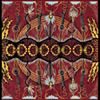
Beta-Lactam Ring
Kellari Juniversumiwas originally issued on a Fonal CD back in 1999, but in light of theFinnish scene's newfound notoriety, it has been re-released in a vinylcollector's edition on Beta-Lactam Ring Records, who also include abonus 7" Saija with every mailorder purchase. Recently, on efforts such as Alkuharka,almost as a reaction to being pidgeonholed by the "freak-folk" happymusic press, Anderzen has increased the presence of samples andelectronics in the music. On Kellari, however, any electronicelements are purely analog, and are hidden so as to be almost entirelyunnoticeable. This lends the album an organic, improvisatory looseness,the multilayered composting of amateurishly played percussion, strings,horns, toy piano, ghostly vocal choruses and undercurrents ofatmospheric drone. Some of the songs sound as if they were recorded inand among Finland's flora and fauna, as the sounds of birds chirpingand twigs snapping can clearly be heard. It is tempting to file awayKY's music as light, pastoral, hippie fare, but deep listening evokesmany a chill wind, Anderzen revealing dark, anxious atmospheresrecalling Comus' First Utterance or the Incredible String Band's Be Gladsoundtrack. Perhaps it is merely the suggestive power of themandala-like folk-art sleeve, but the music also seems to operate onthe level of pagan invocation, as the tribalistic, ritualized groupimprovisations seem to play upon a hidden timbre of forest magic.Because of the multiple-tracking method that Anderzen applies torecording, the various instrumental elements of each song oftenthreaten to derail from each other and create a senseless cacophony,but there is a consistent method to the madness. The more you listen toKellari Juniversumi, the more complex it seems, the more thedisparate elements align and realign into coherent compositionalpatterns that may be intentional, or a product of synchronicity, itdoesn't matter which. Songs generally don't last longer than a fewminutes, as Anderzen prefers to build up his songs vertically, ratherthan horizontally. The music on the bonus 7" is a more recentincarnation of KY, with a decidedly noisier, lower-fidelity atmospheremarked by an almost accidental convocation of percussive elements,metallic scrapes and tortured samples. The sleeve for the bonus singleshows a patchwork of Spare-like sigils, with the back cover aphotography of a man's bare back covered with red welts perfectlyaligned to form the Qabalistic tree of life. This willful esotericismis somewhat pricklier and less beguiling than Kellari Juniversumi, but no less fascinating. - Jonathan Dean
samples:
Read More
- Administrator
- Albums and Singles
Jagjaguwar

Elsewhere, the slowrumbling of "Spirits," "The Heavenly Choir," and "The Beginning isNigh" engulf the listener gradually, ebbing and flowing on theiratmospheric guitar playing and throbbing percussion. While Oneida spenda good deal of time exploring the bong-water stained terrain ofpsychedelic hard rock on The Wedding,they devote just as much time to genteel folk on songs like "Know" and"Run Through My Hair," the latter of which features delicate fingerpicking interspersed with stabs of acid-drenched electric guitar.Elsewhere, songs like "Charlemagne" and "You're Drifting" sound likeearly slices of electronic pop. That Oneida are often lumped aspsych-rock fetishists is a shame, as The Wedding proves thatalthough they make good use of the sounds and ideas of this style, itis hardly a crutch. In fact, when they want to, Oneida are just ascapable of writing a concise pop song as a lengthy stoner anthem, suchas on "High Life," the best synth-pop song I've heard in a long time. Afew songs here sound like stylistic reaches, most notably "Leaves," butin truth it is hard to fault Oneida, as The Wedding is consistently excellent.
samples:
Read More
- Jonathan Dean
- Albums and Singles

Beta-Lactam Ring
They are thepale riders and frontier opportunists of a vast dream of untamedexpanses, deserted gold rush towns that coughed their last dying breathyears ago, unincorporated areas of land not under the jurisdiction ofany government, and thus subject to the brutal justice of itinerantlawmen and unscrupulous gangs. This sort of thing shouldn't surpriseanyone familiar with Tom Carter from his long-time membership in Texasunderground mainstays Charalambides, long reliable purveyors of aparticularly unique evocation of revenant country and blues spirits,but Friday Group takes things to a new level of purity, intensity andhypnotic perfection. The only possible reference points for thisfantastic debut would be Bruce Langhorne's psychedelic soundtrack forPeter Fonda's minimalist B-Western The Hired Hand, Neil Young's Dead Mansoundtrack, or Zoviet France's "Something Spooked the Horses." TomCarter and a group of improvisers that also includes Shawn McMillan,B.C. Smith and Blake Carlisle hit a chord that is long and lonesome,and succeed in making one of the most richly suggestive works ofpost-Americana that I've yet heard from the extended Wholly Otherfamily. The LP is packaged in a plain, "none more black" sleeve, butit's hard to work out if this is The Friday Group's idea or a designstrategy by Beta-Lactam Ring, as this LP is the first volume in theirnew Records Are Not For Baking subscriber series. Those whosubscribe to all six volumes (other artists include irr.app.(ext.), LaSTPO, Nurse With Wound and Aranos), receive all six LPs as well as sixbonus picture disc 12"s by each artist. I'm not sure that The FridayGroup's bonus 12" could be considered a "picture disc" in any sense,unless you consider a few sleeve notes and the color gray to be a"picture." I find the packaging of these two records bland anduninspiring, but it's the only thing that's bland about The FridayGroup, whose music is filled with dense textures and hypnoticatmospheres that belie the drab artwork. The LP is made up of twosidelong tracks of solid improvisation, Carter playing the holy fuckout of his beloved lap steel guitar, pulling out beautifully bending,curling wisps of opium smoke or gritty, sunbaked electric deathrattles, sending up a spray of clay dust or a spattering of saliva witheach sudden turn of his wrist. Filling out the sound are the thick,pregnant drones of McMillan's harmonium, and the vintage organs andelectronic guitar runoff of Smith and Carlisle, with the odd smatteringof windchimes and tumbleweed. The group doesn't meander long beforelocating a blasted-out, sunbleached skeletal blues in the midst oftheir stunningly evocative improvs, with the group carving out plentyof space for Carter's possessed solos. The LP is definitely where it'sat, but the shorter bonus pieces on the bonus disc, which highlight thegroup's gift for complex, shifting harmonic drone, aren't too shabbyeither.
samples:
Read More
- Administrator
- Albums and Singles
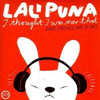 I Thought I Was Over That not only comes off the heels of a successful LP and tour, but the tracks included are of a varied enough nature to please devoted fans who missed a single here or there and curious newbies alike.
I Thought I Was Over That not only comes off the heels of a successful LP and tour, but the tracks included are of a varied enough nature to please devoted fans who missed a single here or there and curious newbies alike.
After a string of critically acclaimed full-lengths, Lali Puna mark 2005 with their very first compilation release, which raises the question: what makes a compilation worthwhile, if not essential? Some artists use these kind of releases as throwaways, to keep an audience's appetite whetted during studio time, or simply loaded up with filler and other fluff to move units in times of need. Not so with Valerie Trebeljahr & Co.: I Thought I Was Over That not only comes off the heels of a successful LP and tour, but the tracks included are of a varied enough nature to please devoted fans who missed a single here or there and curious newbies alike. First of all, there's a ton of material: nearly 80 minutes is enough to fill two pieces of vinyl. Secondly, it's of a varied enough nature—remixes of Lali standards, remixes of other artists' work by Lali, duos, throwaways and a jam (if that's the term in electro-pop) or two—to truly merit the release as more than a convenient collection for those who couldn't track down all the singles. Happily, the remixes are worthwhile, too—rather than superficial changes, they truly add something new to the source material—like putting an addition onto the house rather than just a new coat of paint, or in some cases, like going from a duplex to a lighthouse. Some of Trebeljahr's choices for remixes will turn some heads, too. They're able to "poppify" a track from left-field hip hop outfit Boom Bap, ably adding a verse-chorus-verse setup to an otherwise freewheeling instrumental; Lali Puna even takes a stab at a Giorgio Moroder (he of synthesizers and Scarface fame) composition. The collection is by no means flawless: the Dntl version of "Faking the Books" loses most of the subtle majesty of the original, and some of the new work will be too glitch-pop for the established audience. It's also a little heavy on later material: nearly half the tracks come from 2002 and later. And remixed or no, some of the instrumental tracks seem to wander, and suffer greatly in comparison to those graced by Trebeljahr's simply lovely singing voice. Alternately haunting, soothing and even salacious, any remix or rarity, no matter how adroit or precious, is vying for second place without the presence of her pipes. Not a hackneyed retrospective or throwaway "greatest hits" collection by any means, I Thought I Was Over That seems tailor-made for Lali Puna's loyal listeners: they'll get to see whole new sides of the group's lyrical and compositional abilities (especially if they missed the 2004 Mirconomic EP), and get to be spared the bother of tracking down all the singles. New listeners, though, won't be nearly as rewarded, and would be best advised to pick up Faking the Books or Scary World Theory before moving on to this smorgasbord.
samples:
Read More
- Administrator
- Albums and Singles

Caminate
The tracks alternate, though the package design is so obscurethat the only way to tell which tracks appear in which order is tomatch the times of each to a title and time listed on one of fourdifferent cards inserted in the front pocket of the digipack. The firstpiece is terrific: Merzbow's "Esrma 1" is based on a pattern ofalternating notes which twist subtly as layers of grainy synth-likesounds are added one at a time. It's a very linear and musical piece,with a straightforward upward spiral abruptly ending with what mustbe... a guitar through a flanger. (Uh-oh.) Here's where Tranzstarts to falter. Even without the knowledge of specific guitareffects' sounds, an obvious sound is recognizable, and Elliott Sharpseems incapable of providing much more than off-the-shelf guitar andeffect sounds for the remaining 3/4 of this album. Sharp's first turnat the wheel, "Mares 1," begins with a burbling, flatly-tensebackground bed of grainy noise, but gracelessly throws in suchchestnuts as: the outer-space phaser sound!; The guitar-shopfinger-tapping shred solo (these are cringe-inducing without David LeeRoth in the vicinity)!; The twisting the delay-knob up and down sound!;and so on,.... Sharp marches so blithely over the pleasingly crunchybackdrop that I tried to listen to his piece as if I was hearing tworadio stations at once, absorbing one while information from anotherwas irritatingly bleeding through. On track 3, Merzbow tries again, buthe does not match the focus he started out with, and the final track islittle more than a Max/MSP effect doing its thing uneventfully for afew minutes. If a person was involved in its composition, he appears tohave removed himself before the disc went to press. The asaforementioned intriguing appeal is rather like rubbernecking: peoplewere maimed in this car crash, but it's tough not to keep looking atthem. I have returned to this album four times since I first heard it.It's maybe a good textbook about how two very disparate artists mightforce themselves to work together across styles and methods. It mighteven have worked, had the artists not both phoned in their music. Ifthey'd arrived at a solid idea and explored it, maybe this could havebeen surprising music instead of merely an exercise. Still: ever hearda Merzbow album with finger-tapping on it?
Read More
- Jonathan Dean
- Albums and Singles

Beta-Lactam Ring
With a name only slightly less stupid than German contemporariesHNAS (Hirsche Nichts Aufs Sofa—"Moose Without A Sofa"), and an eclecticsensibility only slightly less whacked-out and surrealistic, La STPOhave trudged on in near-total obscurity for two decades, with arevolving door membership that has included more than 30 musicians overthe years. BLR's '86-'90 reissued the hard to find Illusion EP, together with an equally impossible-to-find LP from 1990. Le Combat Occultedoesn't reissue anything, but instead collects a generous amount ofunreleased, alternate, rare and live tracks drawn from the band'sentire history. La STPO records are always scattershot, rapidlychanging, almost pathologically eclectic affairs, and this one evenmore so, as most of these tracks were not even conceived in eachother's presence. In a strange way, this increased randomnesscontributes to the kind of Dada pranksterism that the band appear to beaiming for, the majority of their songs senselessly shifting musicalgears in ways that only make sense within the post-RIO experimentalprog milieu in which they are generally considered. For all of theirdeliberate goofiness, however, there is very competent musicianship atthe heart of La STPO, and only a talented band could pull off thesebreathlessly dynamic rock gymnastics, switching from histrionicstop-start prog-rock virtuosity to Neanderthal free jazz skronk, toSpike Jones-style cartoon wackiness, to percussive breakdowns onmallets and sheet metal, to tuneful psychedelic ballads and austerechamber music, often within the span of a few minutes. The sillinesscan be downright exhausting at times, but it certainly keeps thingsmoving; I challenge anyone to be bored by the music found on this disc.With their opaque lyrical aesthetic and sleeve designs, the bandclearly align themselves with a long tradition of Europeanavant-gardism of the kind exemplified by Marcel Duchamp and Max Ernst,but they also invoke Russian Suprematism in tracks like "TechniquesExplositionnistes," giving shoutouts to Malevich and Kandinsky. Unlikeother bands such as Nurse With Wound or HNAS that traffic in thesekinds of kitchen-sink compositions, La STPO actually have the musicalchops to pull off these death defying leaps of musical illogic withoutresorting to tape-splicing or plunderphonia. There is a lot more thatcould be said about music as chock full of complexity, eccentricity andobscurity as that made by La STPO, but it's best to just be jerkedalong by these intelligently insane and spectacularly talentedmusicians, and just see where the journey leads.
samples:
Read More
- Lucas Schleicher
- Albums and Singles
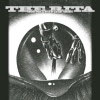
Troniks/PACrec
The Rita, it would seem,follow in the footsteps of these vulgar giants. Two tracks make up this60+ minute record of almost pure white noise, feedback, suffocatedscreams, and unrelenting brutality. The first and most obvious facet ofsuch an approach to noise is obvious: there isn't much variation and onmost releases that makes it too easy for me to get bored. The secondand maybe most ear-catching facet is that when The Rita decide to allowvocal samples and odd sounds bleed through their curtain of damagedequipment, they sound exciting and fresh. I think the image must beholding these fellows down. I'll be the last to say there's an image touphold here, but when one song is titled "Naked Girl Found Dead in thePark" and the artwork depicts what must be a rather brutal rape, themusic inside is likely to exaggerate its real intensity for the sake ofconsistency. It's a shame, too, because while violence can be anattractive and creative event, it seems like most eyes are focused onthe less perverse and more boring, pornographic stuff that shows nosigns of creativity or understanding, whatsoever. At one point on "ViceWears Black Hose," the noise congeals for a moment into the sounds ofwhat might be a sample from a Dario Argento film soundtrack, butinstead of letting such an unsettling transition play its role, TheRita shot things back into a confused and overdriven death fest.Extremes can be interesting at times, but this is one that has beenplayed out one too many times. There are far better explorations of sexand violence out there if that sort of thing seems evenly remotelyinteresting, but the disappointing part is that The Rita show a lot ofpromise on this record and then let me down by trying to drown theirwork in the sort of noise that eventually comes to sound tame and sillybecause of its nonstop intensity. In the end it sounds normal and notat all threatening, almost as though it's become its opposite andobtained a trance-like, subdued state in the pursuit of nonstop,attention-grabbing assault. - Lucas Schleicher
samples:
Read More


